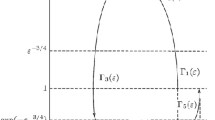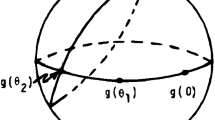Abstract
We characterize a criterion for the existence of relaxation oscillations in planar systems of the form
where \(k\ge 0\) is an arbitrary constant and \(\varepsilon >0\) is a sufficiently small parameter. Taking into account of possible degeneracy of the “discriminant” function occurred when \(k\ge 0\), this criterion generalizes and strengthens those for the case \(k=0\) obtained by Hsu (SIAM J Appl Dyn Syst 18:33–67, 2019) and Hsu and Wolkowicz (Discrete Contin Dyn Syst Ser B 25:1257–1277, 2020). Differing from the case of \(k=0\), our proof of the criterion is based on the construction of an invariant, thin annular region in an arbitrarily prescribed small neighborhood of a singular closed orbit and the establishment of an asymptotic formula for solutions near the v-axis. As applications of this criterion, we will give concrete conditions ensuring the existence of relaxation oscillations in general predator–prey systems, as well as spatially homogeneous relaxation oscillations and relaxed periodic traveling waves in a class of diffusive predator–prey systems.




Similar content being viewed by others
References
Ai, S., Sadhu, S.: Entry–exit theorem and relaxation oscillations for fast–slow planar systems. J. Differ. Equ. 268, 7220–7249 (2020)
Bo, W., Lin, G., Ruan, S.: The effect of initial values on extinction or persistence in degenerate diffusion competition systems. J. Math. Biol. 80, 1423–1458 (2020)
Brunovsky, P.: Tracking invariant manifolds without differential forms. Acta Math. Univ. Comenion. (N.S.) 65, 23–32 (1996)
De Maesschalck, P., Dumortier, F., Roussarie, R.: Cyclicity of common slow fast cycles. Indagationes Mathematicae 22, 165–206 (2011)
De Maesschalck, P., Schecter, S.: The entry–exit function and geometric singular perturbation theory. J. Differ. Equ. 260, 6697–6715 (2016)
Fenichel, N.: Geometric singular perturbation theory for ordinary differential equations. J. Differ. Equ. 31, 53–98 (1979)
Ghazaryan, A., Manukian, V., Schecter, S.: Traveling waves in the Holling–Tanner model with weak diffusion. Proc. R. Soc. A: Math. Phys. Eng. Sci. 471, 20150045 (2015)
Hale, J.K.: Ordinary Differential Equations. Wiley, New York (1969)
Hastings, S.P., McLeod, J.B.: Uniqueness of relaxation oscillations: a classical approach. Q. Appl. Math. 73, 201–217 (2015)
Hsu, T.-H.: On bifurcation delay: an alternative approach using geometric singular perturbation theory. J. Differ. Equ. 262, 1617–1630 (2017)
Hsu, T.-H.: Number and stability of relaxation oscillations for predator–prey systems with small death rates. SIAM J. Appl. Dyn. Syst. 18, 33–67 (2019)
Hsu, T.-H, Ruan, S.: Relaxation oscillations and the entry–exit function in multi-dimensional slow–fast systems.arXiv:1910.06318
Hsu, T.-H., Wolkowicz, G.: A criterion for the existence of relaxation oscillations with applications to predator–prey systems and an epidemic model. Discrete Contin. Dyn. Syst. Ser. B. 25, 1257–1277 (2020)
Hsu, S.-B., Shi, J.: Relaxation oscillation profile of limit cycle in predator–prey system. Discrete Contin. Dyn. Syst. Ser. B 11, 893–911 (2009)
Huzak, R.: Predator–prey systems with small predator death rate. Electron. J. Qual. Theory Differ. Equ. 86, 1–16 (2018)
Jones, C.K.R.T.: Geometric singular perturbation theory. In: Johnson, R. (ed.) Dynamical Systems, Montecatini Terme, Lecture Notes in Mathematics, vol. 1609, pp. 44–118. Springer-Verlag, New York (1994)
Liu, W.: Exchange lemmas for singular perturbation problems with certain turning points. J. Differ. Equ. 167, 134–180 (2000)
Krupa, M., Szmolyan, P.: Relaxation oscillation and canard explosion. J. Differ. Equ. 174, 312–368 (2001)
Kuehn, C.: Multiple Time Scale Dynamics. Springer, Berlin (2015)
Li, C., Zhu, H.: Canard cycles for predator–prey systems with Holling types of functional response. J. Differ. Equ. 254, 879–910 (2013)
Li, M., Liu, W., Shan, C., Yi, Y.: Turning points and relaxation oscillation cycles in simple epidemic models. SIAM J. Appl. Math. 76, 663–687 (2016)
Liu, W., Xiao, D., Yi, Y.: Relaxation oscillations in a class of predator–prey systems. J. Differ. Equ. 188, 306–331 (2003)
Lundstom, N.L., Soderbacka, G.: Estimates of size of cycle in a predator–prey system. Differ. Equ. Dyn. Syst. (2018). https://doi.org/10.1007/s12591-018-0422-x
Piltz, S.H., Veerman, F., Maini, P.K., Porter, M.A.: A predator–2 prey fast–slow dynamical system for rapid predator evolution. SIAM J. Appl. Dyn. Syst. 16, 54–90 (2017)
Schecter, S.: Persistent unstable equilibria and closed orbits of a singularly perturbed equation. J. Differ. Equ. 60, 131–141 (1985)
Schecter, S.: Exchange lemmas. II. General exchange lemma. J. Differ. Equ. 245, 411–441 (2008)
Shen, J., Hsu, C.H., Yang, T.H.: Fast–slow dynamics for intraguild predation models with evolutionary effects. J. Dyn. Diff. Equ. 32, 895–920 (2020)
Stoker, J.J.: Nonlinear Vibrations. Interscience, New York (1950)
Wang, C., Zhang, X.: Stability loss delay and smoothness of the return map in slow–fast systems. SIAM J. Appl. Dyn. Syst. 17, 788–822 (2018)
Wang, J., Zhang, X., Shi, J., Wang, Y.: Profile of the unique limit cycle in a class of general predator–prey systems. Appl. Math. Comput. 242, 397–406 (2014)
Acknowledgements
The authors thank the referee for careful reading of the manuscript and for all valuable comments and suggestions.
Author information
Authors and Affiliations
Corresponding author
Additional information
Dedicated to the memory of Professor Pavol Brunovsky.
Publisher's Note
Springer Nature remains neutral with regard to jurisdictional claims in published maps and institutional affiliations.
The second author was partially supported by NSERC discovery grants 1257749 and RGPIN-2020-04451, a faculty development grant from University of Alberta, and a Scholarship from Jilin University.
Rights and permissions
About this article
Cite this article
Ai, S., Yi, Y. Relaxation Oscillations in Predator–Prey Systems. J Dyn Diff Equat 36 (Suppl 1), 77–104 (2024). https://doi.org/10.1007/s10884-021-09980-6
Received:
Revised:
Accepted:
Published:
Issue Date:
DOI: https://doi.org/10.1007/s10884-021-09980-6
Keywords
- Relaxation oscillations
- Periodic traveling waves
- Singular and regular perturbations
- Predator–prey systems




